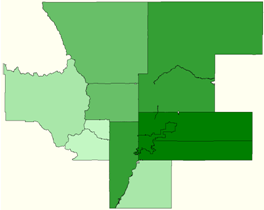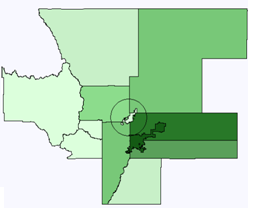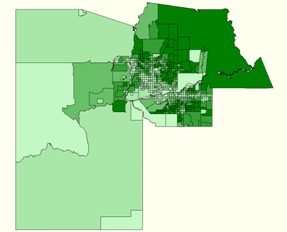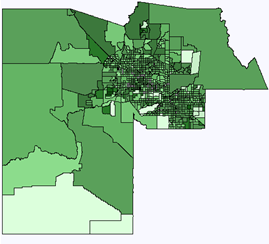2000 Long Form in 2010 Boundaries
↓ Features
↓ Variables
↓ Geography
Comparing census demographics from different census years can be a difficult task due to changing geographic boundaries. Our normalized data product line assists researchers with comparisons of data across time by adjusting and weighting the census data to account for changes in geographies.
If you are working at the state level then there are no changes. But at all smaller geographies there are changes, some of them quiet dramatic some relatively modest. So for example in Colorado between 2000 and 2010 a new county was added – Broomfield. The surrounding 4 counties each spun off a small piece and created this new county (inside the circle on the 2010 map below).
| Map of 2000 Colorado Counties | Map of 2010 Colorado Counties |
 |
 |
To demonstrate some of the issues associated with changing boundaries, below is a comparison of Maricopa County, Arizona in 2000 and 2010 at the Census Tract level. During this time span, Maricopa County expanded its population going from 3,072,149 to 3,817117 – a 24% increase. A quick appraisal of the two maps below demonstrates the numerous changes that occurred in the census tract boundaries, specifically the addition of 253 new tracts in 2010 – a 38% increase.
| 2000Maricopa County, AZTotal Census Tracts (663) | 2010Maricopa County, AZTotal Census Tracts (916) |
 |
 |
While many of these changes were in the most populated central part the outlying areas are the easiest to see these dramatic changes. Where the one large southern tract becomes four smaller tracts.
The Census 2000 Long Form is the most complete source of detailed information about the people, housing, and economy of the United States in 2000. This dataset contains variables such as income, housing, employment, language spoken, ancestry, education, poverty, rent, mortgage, commute to work, etc. There are 5,500 variables at the Block Group level and over 10,000 more variables at the larger geographies such as tract, zip code, county and state level.
Census 2000 Long Form in 2010 Boundaries, like all of our census-based products, comes with built-in data viewing and exporting capabilities as well as thematically shaded, color-mapping capabilities. With a few quick keystrokes you can generate full-blown maps or tables. You can extract data as dbf, ASCII, or shape files and use them as input files for other programs e.g. statistical (SAS, SPSS), database (Access, Oracle), spreadsheet (Excel, 1-2-3), and mapping (Arc View). You can even export any of the geographic boundaries into the mapping packages.
Census 2000 Long Form lets you easily explore, analyze, and visualize an enormous amount of details about the people, housing, industry, economy, and places in the United States – and once it is put into the 2010 boundaries it makes it simple to compare to the changes from the 2010 Summary File 1 (SF1) or the 2010 American Community Survey for an easy apples-to-apples comparison of the population of the United States.
Comparison Table
| Basic | |
|---|---|
| State User | $695.00 |
| National User | $1,295.00 |
| Long Form ST3 valiables | ✪ 813 variables |
CensusCD 2000/Long Form includes such categories of variables as income, housing, employment, language spoken, ancestry, education, poverty, monthly rent/mortgage, commute to work, etc. It contains about 16,000 variables at the tract, zip code level and above and about 5,500 variables at the Block Group level. For a complete list of variables, click here 🗗. The data set will include all of the cross-tabulated variables (income by age, employment by race) released by the US Census Bureau.
Geography
8 geographies covering over 350,000 locations
Census 2000 in 2010 Boundaries gives you access to over 3,500 demographic variables at the Block Group level and above and an additional 10,000 for tract level and above.
These geograhic areas consist of the following levels (numbers indicate how many specific areas are within that geographic level):
- United States (1)
- States (51)
- Congressional District (423)
- Counties (3,143)
- Census Designated Places (29,261)
- Zip Codes (ZCTA) (33,092)
- Census Tracts (73,057)
- Block Groups (217,740)




